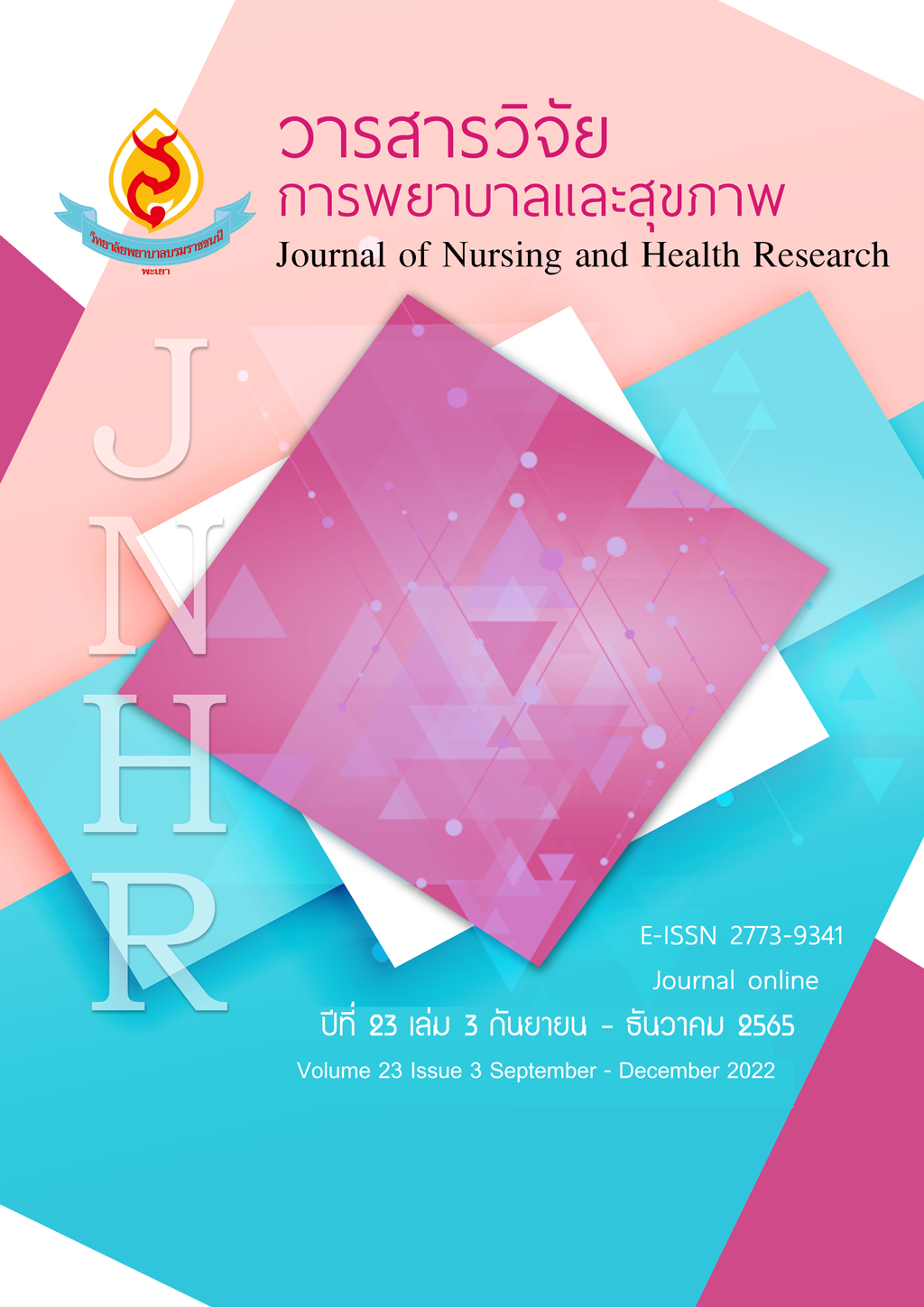การปรับตัวในการดำเนินชีวิตแบบวิถีใหม่ของนักศึกษาพยาบาล
คำสำคัญ:
การปรับตัว, การดำเนินชีวิตแบบวิถีใหม่, นักศึกษาพยาบาลบทคัดย่อ
การปรับตัวในการดำเนินชีวิตแบบวิถีใหม่ของนักศึกษาพยาบาล มีความสำคัญต่อการพัฒนานักศึกษาและทักษะการปฏิบัติตามชั้นปี การวิจัยเชิงพรรณนาครั้งนี้ มีวัตถุประสงค์เพื่อศึกษาการปรับตัวในการดำเนินชีวิตแบบวิถีใหม่ของนักศึกษาพยาบาล กลุ่มตัวอย่าง คือนักศึกษาพยาบาลชั้นปีที่ 1-3 วิทยาลัยพยาบาลแห่งหนึ่ง ปีการศึกษา 2564 จำนวน 201 คน เครื่องมือในการวิจัยคือ แบบสอบถามการปรับตัวในการดำเนินชีวิตแบบวิถีใหม่สำหรับนักศึกษาพยาบาล 4 ด้าน ได้แก่ ด้านการเรียน ด้านสังคม ด้านอารมณ์ และด้านสุขภาพ ผ่านการตรวจสอบความตรงตามเนื้อหา เท่ากับ 1.00 ค่าดัชนีความสอดคล้อง เท่ากับ .60-1.00 และค่าความเชื่อมั่นสัมประสิทธิ์อัลฟาของครอนบาค เท่ากับ .86 วิเคราะห์ข้อมูลโดยสถิติเชิงพรรณนา และการวิเคราะห์ความแปรปรวนทางเดียว ผลการศึกษา พบว่า การปรับตัวในการดำเนินชีวิตแบบวิถีใหม่ของนักศึกษาพยาบาล โดยภาพรวม อยู่ในระดับค่อนข้างดี (=3.91, SD=0.80) การปรับตัวรายด้าน พบว่า การปรับตัวด้านสุขภาพ ด้านสังคม และด้านการเรียน อยู่ในระดับค่อนข้างดี การปรับตัวด้านอารมณ์ อยู่ในระดับพอใช้ จากการเปรียบเทียบความแตกต่างของการปรับตัวระหว่างชั้นปี พบว่า นักศึกษาที่มีระดับชั้นปีแตกต่างกันมีการปรับตัวในการดำเนินชีวิตแบบวิถีใหม่แตกต่างกันอย่างมีนัยสำคัญทางสถิติ (p<.05) ผลการศึกษาครั้งนี้สามารถใช้เป็นข้อมูลพื้นฐานในการเสริมสร้างการปรับตัวในการดำเนินชีวิตแบบวิถีใหม่ของนักศึกษาพยาบาลต่อไป
เอกสารอ้างอิง
กนกพร เรืองเพิ่มพูน, สุดา รองเมือง และพัชรินทร์ นินทจันทร์. (2554). ลักษณะการปรับตัวทางสังคมของนักศึกษาพยาบาล. รามาธิบดีพยาบาลสาร, 17(3), 478-492.
กรรณิการ์ แสนสุภา, เอื้อทิพย์ คงกระพัน, อุมาภรณ์ สุขารมณ์, และผกาวรรณ นันทะเสน. (2563). การปรับตัวของนักศึกษาในสถานการณ์โควิด-19. วารสาร มจร มนุษยศาสตร์ปริทรรศน์, 6(2), 83-97.
กระทรวงสาธารณสุข. (2563). คู่มือการปฏิบัติตามมาตรการผ่อนคลายกิจการและกิจกรรมเพื่อป้องกันการแพร่ระบาดของโรคโควิด 19 สำหรับประเภทกิจการและกิจกรรมกลุ่มที่ 4 และ 5. กรุงเทพฯ: อักษรกราฟิกแอนด์ดีไซน์.
จิราภรณ์ ตั้งกิตติภาภรณ์. (2559). จิตวิทยาบุคลิกภาพและพฤติกรรมสุขภาพ. กรุงเทพฯ: จุฬาลงกรณ์มหาวิทยาลัย.
ประกาศกระทรวงสาธารณสุข (ฉบับที่ 3) พ.ศ.2565 เรื่อง ชื่อและอาการสำคัญของโรคติดต่อที่ต้องเฝ้าระวัง. (2565, กันยายน 19). ราชกิจจานุเบกษา เล่มที่ 139 ตอนพิเศษ 223 ง, หน้า 2.
ทนงศักดิ์ แสงสว่างวัฒนะ, ณิชนันท์ ศิริไสยาสน์, และโชติ บดีรัฐ. (2563). New normal วิถีชีวิตใหม่และการปรับตัว-19: การงาน การเรียน และธุรกิจ. วารสารการบริหาร การปกครองและนวัตกรรม, 4(3), 263-278.
พีรพัฒน์ ใจแก้วมา. (2563). การศึกษาพฤติกรรมการดำรงชีวิตแบบปรกติใหม่ของประชาชนชาวไทยระหว่างวิกฤตโควิด-19 ที่ปรากฏในสื่อออนไลน์ (วิทยานิพนธ์ปริญญาบัณฑิต). พิษณุโลก: มหาวิทยาลัยนเรศวร.
สถาบันส่งเสริมความปลอดภัย อาชีวอนามัยและสภาพแวดล้อมในการทำงาน. (2564). ชีวิตวิถีใหม่ (new normal). สืบค้นเมื่อ 10 พฤศจิกายน 2565, จาก http://www.tosh.or.th/ Covid-19/index.php/new-normal
สมนึก เลิศสุโภชวณิชย์, อาริยา กล่อมกลิ่นสุข, ณัฐทิชา หงษ์สามสิบหก, กรรณิการ์ เจริญไทย, และจริยา ดาหนองเป็ด. (2564). แนวทางปฏิบัติการเฝ้าระวัง ป้องกัน ควบคุม โรคติดเชื้อไวรัสโคโรนา 2019(COVID-19) ในสถานศึกษา [EPub]. จาก http://e-lib.ddc.moph.go.th/pdf/material_990/material_990.pdf.
อวาทิพย์ แว. (2563). COVID-19 กับการเรียนรู้การปรับเปลี่ยนพฤติกรรมสุขภาพในวันนี้. วารสารสมาคมวิชาชีพสุขศึกษา, 35(1), 24-29.
อานันท์ สีห์พิทักษ์เกียรติ, ศิริพร เพียรสุขมณี, พจนา พิชิตปัจจา และชัยวุฒิ ตั้งสมชัย. (2564). COVID-19 Response Research โครงการวิจัยถอดบทเรียนการจัดการเรียนการสอนในรูปแบบออนไลน์ในช่วงสถานการณ์การแพร่ระบาดไวรัส Covid-19 ของมหาวิทยาลัยเชียงใหม่. เชียงใหม่: ศูนย์นวัตกรรมการสอนและการเรียนรู้ มหาวิทยาลัยเชียงใหม่.
Lazarus, R. S., & Folkman, S. (1984). Stress, Appraisal, and Coping. New York, United States: Spring Publishing.
Roger, C.R. (1976). Client-Center Therapy. London: Redwood Burn Limited.
Wallace, J. (2020). The new normal. Citizens and the State in Authoritarian Regimes, 31–58. https://doi.org/10.1093/oso/9780190093488.003.0002
Yamane, T. (1973). Statistics, An Introductory Analysis (3nd ed.). New York: Harper and Row.
ดาวน์โหลด
เผยแพร่แล้ว
รูปแบบการอ้างอิง
ฉบับ
ประเภทบทความ
สัญญาอนุญาต
ลิขสิทธิ์ (c) 2022 วารสารวิจัยการพยาบาลและสุขภาพ

อนุญาตภายใต้เงื่อนไข Creative Commons Attribution-NonCommercial-NoDerivatives 4.0 International License.



